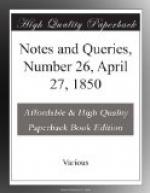W. FRANKS MATHEWS.
Kidderminster, April 7. 1850.
Horns (No. 24. p. 383.).—Rosenmueller ad Exodum xxxiv. 29.
“Ignorabat quods plenderet entis faciei ejus. Vulgatus interpres reddidit. Ignorabat quod cornuta esset facies sua, quia verbum Karan denominativum nominis Keren, cornu; opinatus est denotare, cornua habere; hine nata opinio, Mosis faciem fuisse cornutam. Sed nomen [Hebrew: keren] ob similitudinem et ad radios transferri, docet Haliae, m. 4. ubi de fulminibus dicitur.... Hic denotat emisit radias, i.e. splenduit.” LXX. [Greek: dedoxastai]. Our version, shone.
R. ad Psal. xxii. seems to say, that in Arabic there is the like metaphor, of the sun’s rays to a deer’s horns. R. adds, that the Jews also attributed horns to Moses in another sense, figuratively for power, as elsewhere.
Tauriformis.—The old scholiasts on Horace say that rivers are always represented with horns, “propter impetum et mugitum aequarum.”
“Corniger Hesperidum fluvius.”
An old modern commentator observes, that in Virgil “Rhenus bicornis,” rather applies to its two aestuaries.
When Milton says (xi. 831.) “push’d by the horned flood,” he seems rather to mean, as Newton explains him, that “rivers, when they meet with anything to obstruct their passage, divide themselves and become horned as it were, and hence the ancients have compared them to bulls.”
C.B.
["M.” (Oxford) refers
our correspondent to Facciolati,
Lexicon, ed. Bailey,
voc. Corun.]
Horns (No. 24. p. 383.).—1. Moses’ face, Ex. ch. xxxiv. (karan, Heb.), shot out beams or horns of light (from keren, Heb.); so the first beams of the rising sun are by the Arabian poets compared to horns. Absurdly rendered by Aqu. and Vulg. (facies) cornuta erat. Whence painters represent Moses as having horns.—Gesenius, Heb. Lex. {420}
2. There appear many reasons for likening rivers to bulls. Euripides calls Cephisus taumomorphos, and Horace gives Aufidus the same epithet, for the same reason probably, as makes him call it also “longe sonans,” “violentus,” and “acer;” viz., the bull-like roaring of its waters, and the blind fury of its course, especially in flood time. Other interpretations may be given: thus, Milton, Dryden, and others, speak of the “horned flood,” i.e., a body of water which, when it meets with any obstruction, divides itself and becomes horned, as it were. See Milt. P.L. xi. 831., and notes on the passage by Newton and Todd. Dryden speaks of “the seven-fold horns of the Nile,” using the word as equivalent to winding stream. It would be tedious to multiply examples.
3. Of this phrase I have never seen a satisfactory explanation. “Coruna nasci” is said by Petronius, in a general sense, of one in great distress. As applied to a cuckold, it is common to most of the modern European languages. The Italian phrase is “becco cornuto” (horned goat), which the Accademici della Crusca explain by averring that that animal, unlike others can without anger bear a rival in his female’s love.




